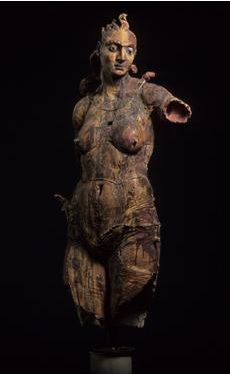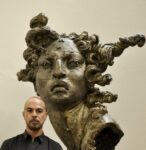Javier Marin in the Studio (video 9:00)

Javier Marin
Mexican, 1962-
Rojo intenso, 1995
clay, metal staples
57 × 17 1/2 × 24 1/2 in.
SBMA, Museum purchase with funds provided by 20th century Art Acquisition Fund
1996.9

undated photo of Javier Marin beside his sculpture "Cabeza de Mujer"
"There are 500,000 Marins inside me that escape and lie hidden in each sculpture I make." - Javier Marin
RESEARCH PAPER
That Javier Marin was only 34 years old [when this paper was written in 1996] is inconceivable as we stand before his ceramic sculpture of an armless female torso, "Rojo intenso" (1995). The sculpture embodies the history of western art from Athens through Michelangelo and Pontorma to Rodin. In addition, the Meso-American culture speaks to us in the hand-modelled clay, seemingly reassembled from broken fragments as if we are viewing an archeological remnant of a lost culture. However, these cultures, the European and the native Meso-American, join in Javier Marin's figures to create for us his internal experience of self. He talks of his sculptures as self-portraits, "placed in very beautiful boxes: there are 500,000 Marins inside me that escape and lie hidden in each sculpture I make."
His art history is experiential rather than intellectual. As a small boy, one of ten brothers growing up in Uruapan, Michoacan, Mexico (about 200 miles west of Mexico City), he knew that he was an artist, even though he had no idea at the time that such a calling even existed. He modeled small figures from clay, creating a play world which sought realistic images.
"I was obsessed with making a small clay monkey to discover exactly how its eye, its hand were." He began to trace the outlines of nudes from books of reproductions, of Reubens, for example, learning the images of the great European painters as hollow contours, much like his work at present. Even today, he works without models, because the sitter's personality intrudes on the rich store of images which he carries with him.
His university art studies began in 1980 when he was eighteen at San Carlos, the National Academy of Art in Mexico City, and continued through 1983, as he went through one studio after another, learning carving, casting, ceramics and painting. He settled on the latter as the medium providing him with the most latitude for experimentation. And experiment he did, producing abstract canvases which expressed the cognitive aspect of his ultimate work, canvases which received acclaim on their own. Yet, when he ultimately laid his hand on the silken surface of clay, he knew he had found that outline, the skin which could clothe his characters. Javier Marin insists that his images are full personalities, as if he were the creator. And truly he is, for we experience in his figures enigmatic personages containing the entire history of art's exploration of the human figure: The classical, the baroque, the romantic, the existential, and that strange amalgam which is the Latin American understanding of the meeting between today and yesterday, between reality and myth.
The clay figures themselves are daunting. Slightly larger than life-sized, they carry on their lives ignoring us, yet somehow aware of our gaze. They certainly do not project the isolation of many twentieth century figurative sculptures. They know our lives, have been three, but have emerged differently. They also carry the past, in very tangible form. These figures remind us of archeological remains which have been reassembled from some remote excavation. The large metal staples piece the clay pieces virtually regardless of the integrity of the pieces themselves, intent on preserving the overall form. We recall the ancient Latin American clay, the pots, the icons, the holy images, now mostly in ruins, destroyed by colonial invaders. Javier Marin's images in an almost magical way combine that Meso-American Indian heritage with the classical serenity of the Greeks and Romans.
We are struck by many other aspects of these figures. Javier Marin is not interested in a simple message. He is probably not interested in any message at all. He seems to invite our engagement with his characters, an invitation to share in his unique vision of the human condition which contains all human history, all experience of sexuality, the betrayal of time, the grandeur of this moment.
His non-message is conveyed through the often furiously worked surface of the clay, suggesting draperies, sudden movement, daubs of earth, smears and drips of pigment, some glazed - some raw. This surface translates into a history of the piece, as if it had been unearthed, reassembled, and varies the marks of fires, destruction, and cryptic inscriptions from times long lost.
Often, contemporary phrases are inscribed in the clay, a fragment of a song on the radio, a snippet of conversation between two of his helpers. This surface is in fact a record of the artist's mood, an expressive pallet of his feelings as he responds to the personaje (personage) emerging under his hands.
Today, in his studio in Mexico City, Javier Marin is working on monumental pieces, reassembled clay artifacts from the depths of his imagination. Some are cast in bronze, but the maquettes are always clay. The process of achieving these reassembled figures is so complex that it is not surprising that few ceramicists attempt it. The completed figure is cut apart at exactly that moment when the clay has enough integrity to hold the shape yet can still be cut. The cut pieces are dried, keeping the thicker areas dampened so that all dry at the same rate. Otherwise, each piece would warp. The basic mixture of clays is a formula derived over years of trial and error. Javier Marin combines porous and soft clays. those from Oaxaca and from Zapoteca to achieve clay which will fire without warping. Otherwise his finished sections would not fit when he attempted to reassemble them. His is a craft rarely perfected.
In standing before our beautiful and awe-ful "Rojo intenso" (1995) , I wonder what old messages I did not receive that I now need; what I can now learn from this proud, truncated, reconstructed goddess, daubed and defaced in red paint, cut with untranslatable scratches. Perhaps it is something about her abounding beauty, her superb passion, her dignity, her "in your face" sauciness. Maybe part of it is the multifarious nature of human experience, the intangible, shifting, eminently complex possibility of a person's life.
Prepared for the SBMA Docent Council by Ricki Morse, August 1996
BIBLIOGRAPHY
Arteaga, Augustin, "Restoration to the Pedestal." Javier Marin: Passionate Body with Skin of Clay, exhibition catalogue, September 1994 - January 1995, Museo de Arte Contemporaneo de Monterrey, Monterrey, Mexico. See translation by Ricki Morse and Carol Pigeon in the SBMA library.
Telephone interview with Tere Iturralde, August 1996, Iturralde Gallery, Los Angeles, California
